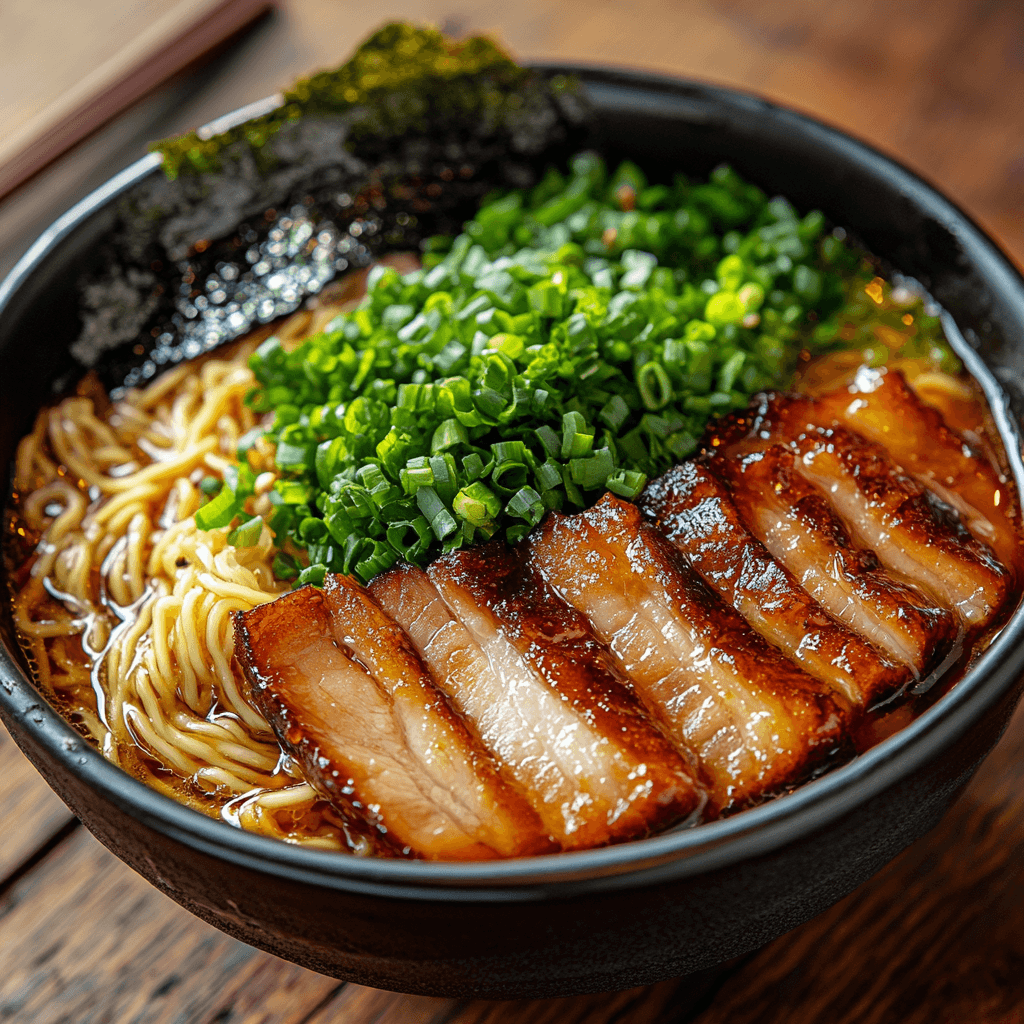The heart of any ramen dish lies in its rich medley of flavors, and the pork belly, often prepared as chashu, is a standout ingredient. What does pork belly taste like in ramen? This tantalizing question opens a world of savory possibilities, where textures and taste meld with steaming broths and noodles. Pork belly adds a luscious, umami-packed richness to ramen, making it one of the most cherished toppings in Japanese cuisine.
Moreover, the preparation method plays a pivotal role in elevating pork belly’s flavor. Braised to perfection, its savory sweetness complements the broth, while the melt-in-your-mouth texture provides a luxurious experience. Whether you’re exploring tonkotsu ramen or a lighter miso broth, pork belly stands out as the centerpiece that ties all elements together.
Key Takeaways
| Aspect | Description |
|---|---|
| Taste | Savory, slightly sweet, and deeply umami-rich, blending perfectly with ramen broths. |
| Texture | Tender, fatty, and melt-in-your-mouth softness, enhanced by braising or roasting techniques. |
| Complementary Flavors | Balances well with rich, creamy broths or lighter, soy-based ramen variations. |
The Importance of Toppings in Ramen
How Pork Belly Toppings Define Ramen Flavor Profiles
Ramen’s essence lies in the harmonious interplay of its toppings. Traditional options like seaweed, soft-boiled eggs, and green onions provide variety, but it’s the pork belly that often steals the show. These additions are not mere garnishes—they’re integral to building the dish’s unique taste. Each topping adds texture, flavor, or aroma, enriching the overall experience.
Not only do toppings enhance ramen’s complexity, but they also highlight regional differences in Japanese cuisine. For instance, in Hokkaido-style ramen, corn and butter are key toppings that create a creamy richness, while Kyushu ramen relies on silky pork fat to boost its tonkotsu broth. Pork belly, with its decadent fat and flavor absorption, remains universally loved.
Example of Toppings Impact on Flavor:
- Seaweed (Nori): Adds a briny taste that contrasts well with rich broths.
- Soft-Boiled Egg: Creamy yolk enriches the broth’s texture.
- Pork Belly (Chashu): Offers a luxurious, umami-packed richness.
What Does Pork Belly Taste Like in Ramen Compared to Other Toppings?
What does pork belly taste like in ramen when compared to other toppings? Pork belly outshines other proteins, like chicken or tofu, due to its unmatched depth of flavor. Its umami-packed richness and tender texture are heightened by slow cooking. For instance, chicken might provide a milder, leaner taste, while tofu works best in lighter broths. However, neither delivers the boldness of chashu pork belly, which melds seamlessly with both creamy and soy-based ramen.
Interestingly, the interplay between pork belly and ramen broth creates a symphony of flavors. Its fattiness dissolves into the liquid, enhancing the broth’s depth, while its sweet and salty notes add a dynamic contrast. While other proteins are enjoyable, pork belly remains a quintessential topping, embodying the soul of ramen.
The Unique Characteristics of Pork Belly in Ramen

Why Pork Belly Stands Out in Ramen Toppings
Pork belly’s distinctiveness lies in its perfect balance of fat and lean meat, making it an indulgent choice. When braised as chashu, it absorbs a marinade of soy sauce, sake, sugar, and aromatics, resulting in layers of complex flavor. The fat renders during cooking, yielding a buttery texture that’s hard to replicate.
Moreover, its adaptability to different ramen styles sets it apart. Whether paired with a creamy tonkotsu broth or a light shoyu base, pork belly enhances the overall dish. Its presence elevates even the simplest bowls, demonstrating its importance in Japanese cuisine.
Key Features of Pork Belly in Ramen:
- Flavor Absorption: Pork belly absorbs braising sauces, enhancing its depth.
- Fatty Marbling: Creates a melt-in-your-mouth effect.
- Universal Appeal: Complements both rich and light ramen broths.
The Umami and Savory Sweetness of Pork Belly in Ramen
One of the most celebrated aspects of what pork belly tastes like in ramen is its harmonious flavor profile. The braising process imbues the meat with savory and sweet notes, while its natural fat adds an umami-rich depth. This balance ensures that the pork belly doesn’t overpower the broth but instead melds seamlessly into it.
Additionally, the umami flavor in pork belly complements ramen’s other elements, such as miso or soy sauce, creating a cohesive dish. The sweetness from the marinade cuts through the fattiness, providing a balanced bite every time. This intricate balance makes pork belly indispensable in traditional ramen bowls.
“Pork belly is the crown jewel of ramen—it transforms a simple bowl into an extraordinary experience.”
Preparation Methods That Impact Pork Belly’s Flavor in Ramen
Braising Pork Belly to Enhance Ramen Flavor
The traditional Japanese method of preparing pork belly, known as chashu, involves braising the meat in a flavorful liquid. Ingredients like soy sauce, mirin, and sugar infuse the pork with rich, caramelized flavors. This slow-cooking method ensures that the meat remains tender while the fat renders beautifully.
Moreover, braising enhances the pork belly’s ability to complement ramen. The process not only tenderizes the meat but also creates a glaze that integrates seamlessly with the broth. Learn more about making authentic chashu pork belly.
Roasting and Grilling Pork Belly Variations for Ramen
While braising is the classic preparation, roasting and grilling provide exciting alternatives. Roasted pork belly develops a crispy exterior, adding a textural contrast to ramen’s softness. Grilling introduces a smoky flavor, which pairs well with shoyu or miso broths.
Not only do these methods diversify ramen, but they also cater to different palates. For instance, grilled pork belly works beautifully in ramen styles with a lighter base, offering a slightly charred, smoky dimension. Each method showcases pork belly’s versatility, reaffirming its status as a beloved topping.
Flavor Comparison by Preparation Method:
- Braising: Tender, sweet-savory richness.
- Roasting: Crisp exterior with a juicy interior.
- Grilling: Smoky, caramelized taste.
What Does Pork Belly Taste Like in Ramen Broths?
Why Pork Belly Complements Tonkotsu Broth
The creamy, rich tonkotsu broth perfectly matches the decadence of pork belly. Its fat melts into the broth, enhancing its velvety texture and deepening the umami flavor. The slightly sweet, salty glaze of chashu pork belly adds balance to the savory base, making tonkotsu a standout ramen variety.
Pork belly’s ability to blend into the broth while maintaining its tender texture creates a multi-layered taste experience. This pairing highlights the importance of selecting the right toppings to elevate any ramen dish.
How Pork Belly Enhances Tonkotsu Ramen:
- Adds richness and depth to the broth.
- Balances savory flavors with sweet notes.
- Creates a contrast with chewy noodles.
Adapting Pork Belly for Lighter Ramen Styles
In broths like shoyu and miso, pork belly adjusts beautifully. Shoyu’s soy-based flavors pair well with the sweetness of chashu, while the umami in miso ramen complements the pork’s natural fattiness. Thinly sliced pork belly works best with lighter broths to avoid overpowering their delicate profiles.
Pro Tip: Pair miso broth with lightly grilled pork belly for a smoky twist.
Textural Appeal of Pork Belly in Ramen
The Luxurious Melt-in-Your-Mouth Texture
One of pork belly’s most appealing qualities is its tender, buttery texture. Achieved through slow cooking, this softness contrasts with firm noodles and crisp toppings, enhancing every bite. The marbling in pork belly ensures it remains moist and flavorful throughout the cooking process.
Why Texture Matters:
- Adds richness to each bite.
- Creates harmony with other elements like noodles.
- Elevates the overall mouthfeel of the dish.
The Role of Fattiness in Enhancing Flavor
The fat in pork belly doesn’t just create a velvety broth—it carries and amplifies the flavors of the dish. This richness balances the sharper notes of pickled or spicy toppings, ensuring every ingredient shines without competing.
Chef’s Note: “Pork belly fat is the secret to a perfect ramen broth.”
Nutritional Insights and Balance

The Nutritional Profile of Pork Belly
While pork belly is rich in calories and fat, it also provides essential nutrients like B vitamins, zinc, and selenium. These support energy production and overall health. To balance its indulgence, add fresh vegetables like spinach or bamboo shoots to your ramen.
Nutritional Highlights:
- High in energy and flavor.
- Provides essential minerals but requires moderation.
Tips for Enjoying Pork Belly in Moderation
Limit portion sizes to a few thin slices to enjoy the flavor without overindulging. Pairing pork belly with lighter broths like shoyu or vegetable-based options helps maintain a balanced meal.
Choosing the Right Cut for Ramen
Why Pork Belly is the Go-To Choice
Pork belly’s balance of fat and lean meat makes it ideal for ramen. The marbling allows it to absorb braising marinades like soy sauce and mirin, ensuring tender, flavorful chashu. For leaner options, pork shoulder or loin can work but lack the same indulgent richness.
Pork Cuts for Ramen:
- Pork Belly: Tender and rich, the classic choice.
- Pork Shoulder: Leaner but still flavorful.
- Pork Loin: Best for lighter broths.
Alternatives to Pork Belly
Chicken chashu is a popular substitute for those seeking a lighter option. Its tender texture pairs well with most broths, offering a milder flavor. Other creative alternatives include duck or beef brisket for a unique twist on traditional ramen toppings.
Common Questions About Pork Belly in Ramen
Does Pork Belly Taste Different in Various Broths?
Yes, what pork belly tastes like in ramen varies significantly depending on the broth it accompanies. In a creamy tonkotsu broth, pork belly’s natural fattiness enhances the soup’s velvety texture and deepens its umami flavor. The rich, collagen-infused broth melds with the pork belly’s tender meat and sweet-salty glaze, creating an indulgent and cohesive dish.
In contrast, lighter broths such as shoyu or miso highlight the subtler notes of the pork belly. Shoyu’s soy sauce base pairs beautifully with the slightly sweet braised pork, balancing the broth’s saltiness. Meanwhile, miso ramen benefits from the umami-packed richness of pork belly, which complements the fermented, earthy flavors of the miso paste. Each combination provides a unique flavor profile that showcases pork belly’s versatility in adapting to various ramen styles.
Furthermore, the cooking method affects how pork belly interacts with different broths. For instance, grilled pork belly introduces a smoky dimension that works well with lighter broths, while braised pork belly retains a caramelized sweetness that enhances tonkotsu. These subtle shifts in flavor make pork belly an irreplaceable topping for ramen enthusiasts.
How Does Pork Belly Compare to Other Ramen Proteins?
When comparing pork belly to other ramen proteins, its rich flavor and tender texture set it apart. Chicken chashu, for instance, offers a leaner and milder taste, making it suitable for lighter ramen varieties. However, it lacks the depth and fattiness of pork belly, which is essential for elevating creamy broths like tonkotsu. Similarly, tofu, often used as a vegetarian alternative, adds a delicate texture but cannot replicate the umami-packed richness or the melt-in-your-mouth quality that pork belly provides.
Moreover, pork belly’s ability to absorb the flavors of its marinade gives it an edge. Traditional chashu preparation infuses the meat with a harmonious blend of soy sauce, mirin, sake, and spices, creating layers of savory, sweet, and slightly smoky notes. This depth ensures that every slice of pork belly enhances the ramen experience, from the first bite to the last.
For those exploring other options, understanding the best cut of pork for ramen can help you appreciate why pork belly remains the ultimate choice. While other proteins have their merits, they often serve as secondary options rather than focal points. Pork belly, with its balance of flavor, fat, and tenderness, remains the gold standard of ramen toppings.
Final Thoughts on What Pork Belly Tastes Like in Ramen
Pork belly is undoubtedly a transformative ingredient in ramen, bringing a luxurious combination of flavor and texture to this iconic dish. What does pork belly taste like in ramen? It is a masterful blend of savory, sweet, and umami flavors, with a rich, melt-in-your-mouth tenderness that complements every broth it meets. Whether in a creamy tonkotsu, a soy-based shoyu, or a miso ramen, pork belly adapts effortlessly to elevate the overall flavor profile.
Additionally, its versatility makes pork belly suitable for various cooking methods. Slow-braised chashu offers a tender and caramelized option, while grilled pork belly adds a smoky depth. Each preparation showcases a different facet of pork belly’s flavor, ensuring there is a style for every palate to enjoy. Not only does pork belly enhance ramen’s taste, but its textural contrast with chewy noodles and crisp toppings creates a balanced and satisfying dining experience.
For those curious about what pork belly tastes like in ramen, there is no substitute for experiencing it firsthand. Try experimenting with homemade ramen recipes featuring pork belly, or explore ramen shops that offer authentic versions of this beloved topping. For insights into selecting the right pork cut, check out the best cut of pork for ramen. Not only will pork belly likely become a favorite, but its rich flavor and versatility will deepen your appreciation for the art of ramen-making.
Whether you’re a long-time ramen enthusiast or new to the dish, one thing is certain: the answer to “what does pork belly taste like in ramen” is an unforgettable combination of bold flavors and indulgent textures that make every bowl a delight.

